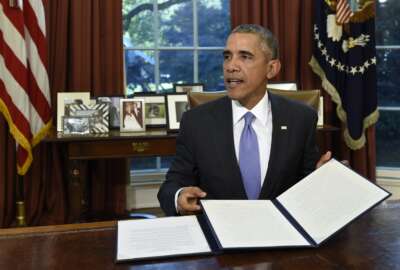
Budget deal puts NDAA back on track
Congress will rework the Defense authorization act to conform to budget deal parameters if it cannot garner enough votes to override the President’s veto.
The announcement of a budget deal between Congress and the White House has breathed new life into the 2016 Defense authorization bill.
The news comes just one week after President Barack Obama vetoed the bill in order to push Congress to solve the sequestration problem and stop using an emergency account to partially fund the Defense Department.
The House and Senate Armed Services Committees will work together to conform the bill to the budget deal parameters if Congress does not override the President’s veto, said a congressional staffer.
The veto is unlikely to be overridden considering the House did not gin up enough votes when the bill originally passed to meet the two-thirds requirement of each legislative body to overturn a veto. It seems like a remote chance that enough representatives will switch their vote to fulfill that requirement.
Cutting from, not eliminating small projects
The budget deal comes about $5 billion short of the $612 billion the bill authorizes for DoD in fiscal year 2016, the staffer said. The sequestration budget caps before the budget deal were set at $523 billion. The bill currently sets the Defense base budget at sequestration levels and then fills in the rest of the funding with overseas contingency operations (OCO) funding. OCO was created to give money to emergency operations and war needs and is not subject to sequestration caps. Now the sequestration cap has been raised to $545 billion.
That $5 billion gap between the new cap and the authorization act would likely be made up by cutting extra programs and material Congress added to the President’s request, said Mandy Smithberger, director of the CDI Straus Military Reform Project at the Project on Government Oversight in an interview with Federal News Radio.
“They are most likely to cut are areas that were unfunded requirements,” she said. “Some places they could look to cut are the 12 additional F-18s that they added, which cost about $1 billion or the six additional F-35 Joint Strike Fighters they added, which is about $846 million.”
Brian Clark, a senior fellow at the Center for Strategic and Budgetary Assessments, said DoD may also make cuts to large procurement plans that will be nominally affected by funding cuts.
“They are going to take some of that money out of operations and maintenance because it’s more fungible,” Clark said. “DoD can just reduce the amount of operations and maintenance funding and DoD would then have to reduce the amount of operations and maintenance they do and they’ll take some of it out of procurement programs that are large and can absorb a reduction in funding and restructure their schedule a little to accommodate it.”
Clark said Congress would be wary of cutting from small programs because it would not want to eliminate them.
A little bit of certainty
President Obama’s main reason for vetoing the bill was that it used the OCO account to fund items that would usually be in the base budget.
Clark said the President’s objection was that Congress was using OCO to increase the base budget without reaching sequestration, but not increasing domestic spending. Therefore domestic spending would be stuck at sequestration levels, while defense spending would not. The new budget deal increases the threshold for both domestic and defense spending.
Congress has used this tactic in the past.
“If you look at the past three to five years, DoD has put an increasing amount of enduring operations and maintenance, things that are normal day-to-day operations that are not necessarily associated with the wars over in the Middle East … into the OCO budget,” Clark said.
Smithberger added that because it’s considered emergency spending, Congress has the authority to fund things with the account that have nothing to do with war spending. She said that between 2001 and 2014, $71 billion of OCO was used for non-war spending.
This year almost $90 billion was placed in OCO before the budget deal, putting even more than usual base budget items in OCO.
Another reason the executive branch gave pause to the OCO spending is that it makes it harder for DoD and the military services to plan for the future, Smithberger said. OCO spending is only allocated for one year.
Budget uncertainty is something that has plagued DoD and the military services since sequestration began. Without knowing what kind of budgets it can work with DOD has trouble planning long-term programs and starting new ones.
Democrats have consistently called the use of OCO for base budget items a gimmick and still have qualms about how it throws off DoD planning.
The new budget deal approves $59 billion for OCO spending in fiscal year 2016. Clark said Congress will try to stuff as much O&M spending as it can into OCO to make room for procurements and other programs in the base budget so it can give DoD as much certainty as possible.
The budget is a two-year deal, so it gives the military at least a little bit of certainty when planning for the future.
The defense sequestration caps have been raised to $551 billion for fiscal year 2017, with $59 billion guaranteed in OCO.
Even so, 2016 was going to be the nadir of the sequestration cuts. The cuts are less drastic going forward, giving DoD at least a little more certainty about how much it will be able to spend if Congress is unable to reach another deal to avert sequestration for fiscal year 2018.
Copyright © 2025 Federal News Network. All rights reserved. This website is not intended for users located within the European Economic Area.
Scott Maucione is a defense reporter for Federal News Network and reports on human capital, workforce and the Defense Department at-large.
Follow @smaucioneWFED





